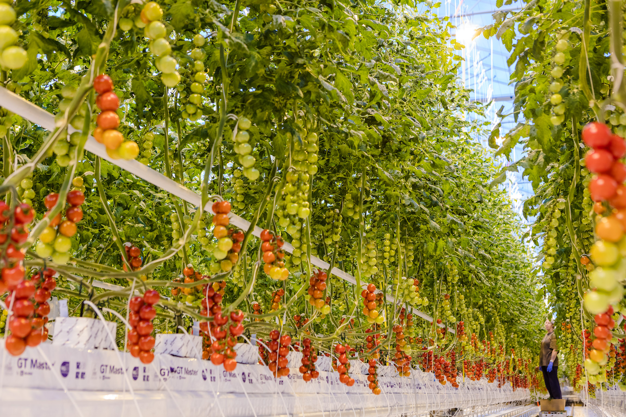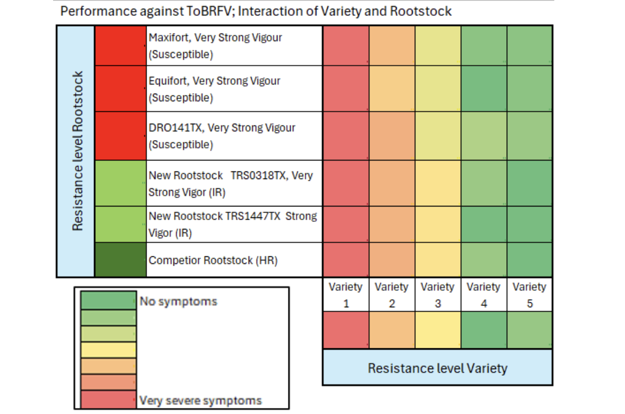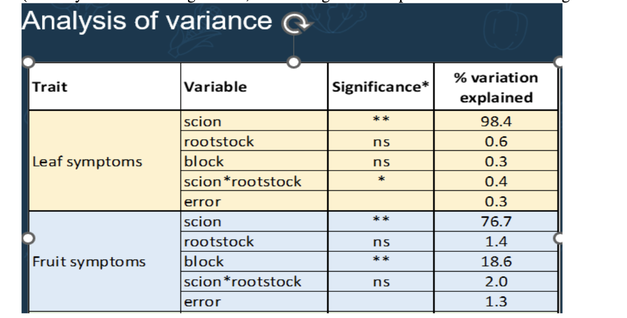Growers still have questions about the tomato brown rugose fruit virus (ToBRFV). One key question involves the impact of ToBRFV-resistant rootstocks on the performance of the scion. Does it make sense to choose a resistant rootstock, and will doing so help protect the crop against the disease? Bayer has conducted specific additional research to help answer this question.

According to Bayer's most recent research, the choice of rootstock does not affect ToBRFV symptoms in the crop, confirming the results of previous work in this area. "The rootstock does not appear to bring additional value to the crop in terms of ToBRFV. Resistant rootstocks might give peace of mind to the grower, but in practice, the severity of fruit and leaf symptoms are determined by the scion: the resistance status of the rootstock seems irrelevant", they claim.
For the last trial in November 2023, 10 different rootstocks in the Netherlands were sowed. These included rootstocks known to be resistant to ToBRFV (including a competitor's variety) and those known to be susceptible, such as Maxifort and DRO141TX. Five crop varieties with different levels of ToBRFV resistance were then grafted onto each of these rootstocks, including the well-known intermediate-resistant variety Ferreira, and the susceptible variety Marinice.

The crops were planted in early January and 8 days later, all the scions were vaccinated with Pepino Mosaic Virus, then inoculated with ToBRFV after another 9 days. Every combination of rootstock and scion was planted in 3 plots, each containing 4 plants. The plants were grown hydroponically in a peat substrate without artificial light – and the severity of ToBRFV symptoms was assessed on leaves as well as ripe fruit.
"Five factors were analyzed in terms of their possible influence on the severity of ToBRFV symptoms in each plant: scion influence on the virus expression, rootstock influence on virus expression, the interaction between scion and rootstock in performance against the virus, any location or block effects, and other statistical errors, i.e., any variation in symptom severity that can't be assigned to other variables above", the research team explains.
A statistical technique known as Analysis of Variance (or ANOVA) was used to assess which of the above variables were significant in the different expressions of ToBRFV symptoms in the 50 possible combinations of varieties and rootstocks.
According to the research done by Bayer, leaf symptoms were only affected by the resistance level of the scion and the rootstock had no significant impact on leaf symptoms. "Very similar results were also seen in terms of fruit symptoms. Once the block effect is discounted (i.e. any differences that occurred due to the location of the plots within the greenhouse) the fruit symptoms were shown to only have been impacted by the resistance level of the scion, not the rootstock."

"The various combinations of scion and rootstock were analyzed separately so possible interaction effects between the two can be considered, but the results supported our initial position that varieties do not appear to perform differently with various rootstocks", the Bayer team says. "Based on this and our earlier research the rootstock does not prevent, or protect, the scion from getting infected by ToBRFV, no matter what level of resistance is claimed for the rootstock in its own right. In practice, the rootstock does not stop the scion from showing leaf and/or fruit symptoms", they say.
"When the plant is infected with ToBRFV via the leaves, the roots will eventually accumulate the virus in both susceptible and resistant rootstock varieties. A resistant rootstock does not create a barrier between the scion and the rootstock."
"Therefore", the Bayer team concludes, "while rootstock choice remains important for characteristics such as plant vigor, endurance, generativity, and resistance against root diseases like fusarium, and nematodes, etc. it has no significant effect on ToBRFV. The resistance level of the scion is what determines the plant's performance against ToBRFV."
For more information:
Bayer
www.bayer.com
